This post – How to Cook Rice The Japanese Way – is all about the Japanese way of cooking rice. Preparing rice is one of the fundamentals of Japanese cooking. It is not boiled like pasta, it is cooked using the so-called absorption method. But there are more secrets to it.
I have included methods not only for cooking rice in a saucepan but also using a rice cooker in this post.
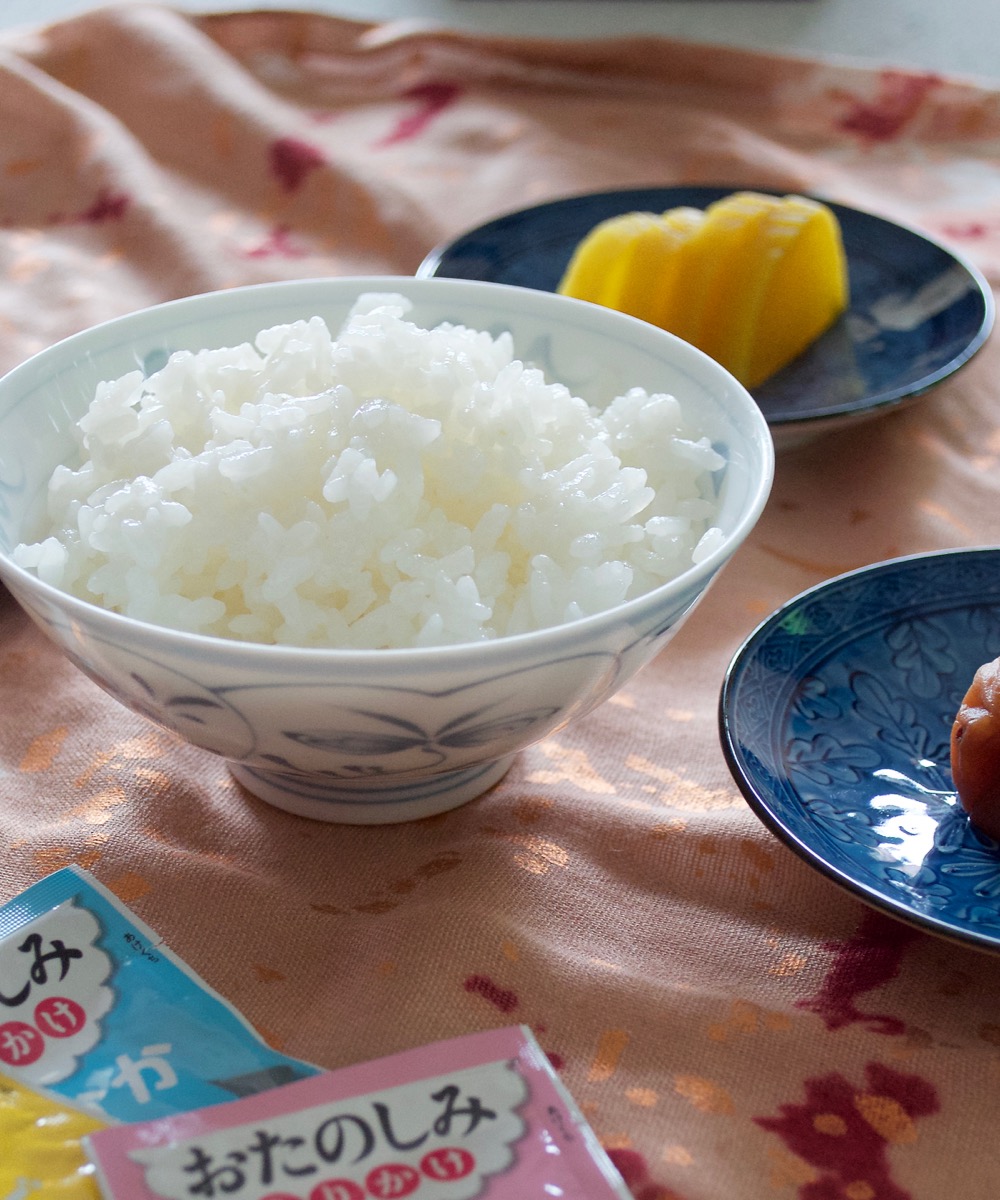
In Japanese culture, cooking rice (okome, お米) is almost an art. At home appliance stores in Japan, you will find so many different types of electric rice cookers on display.
About Rice in Japanese Cooking
Rice is one of the most important staple foods for Japanese people. People have a favourite brand of rice grain, and they strive to cook the best rice possible. Hence, most Japanese people have an electric rice cooker that will deliver consistent results.
Japanese rice is a short grain white rice that is fluffy and slightly sticky. Unlike long grain rice, including Basmati rice and jasmine rice, Japanese rice grains stick to each other when cooked. This is quite important because you can easily pick up a mouthful of rice with chopsticks.
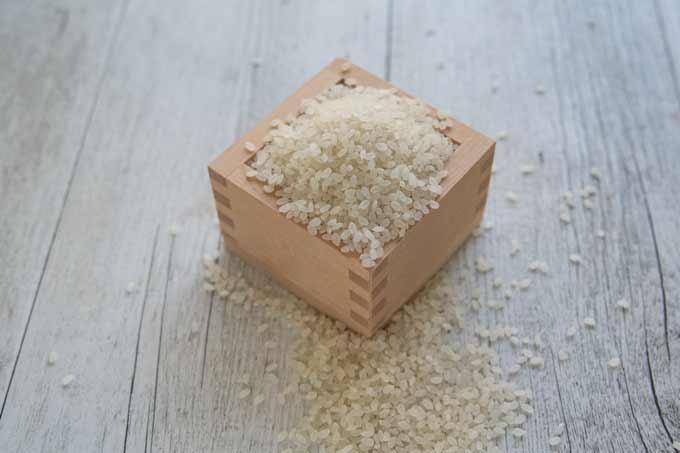
The brand of rice grain is also a critical factor. There are so many different brands from all over Japan as well as overseas and competition is fierce. Japanese farmers put a lot of effort into the pursuit of producing the best rice grain.
The high quality of rice however also means a high price. But many Japanese people say that they are happy to pay a lot for good rice, even if they have to buy cheaper side dishes to go with it.
Brands of Japanese Rice
If you are interested in trying Japanese rice, I would recommend the brand called Koshihikari (こしひかり or コシヒカリ). Koshihikari is one of the best brands of rice grain, noted for its sweet taste. It is the most popular brand in Japan.
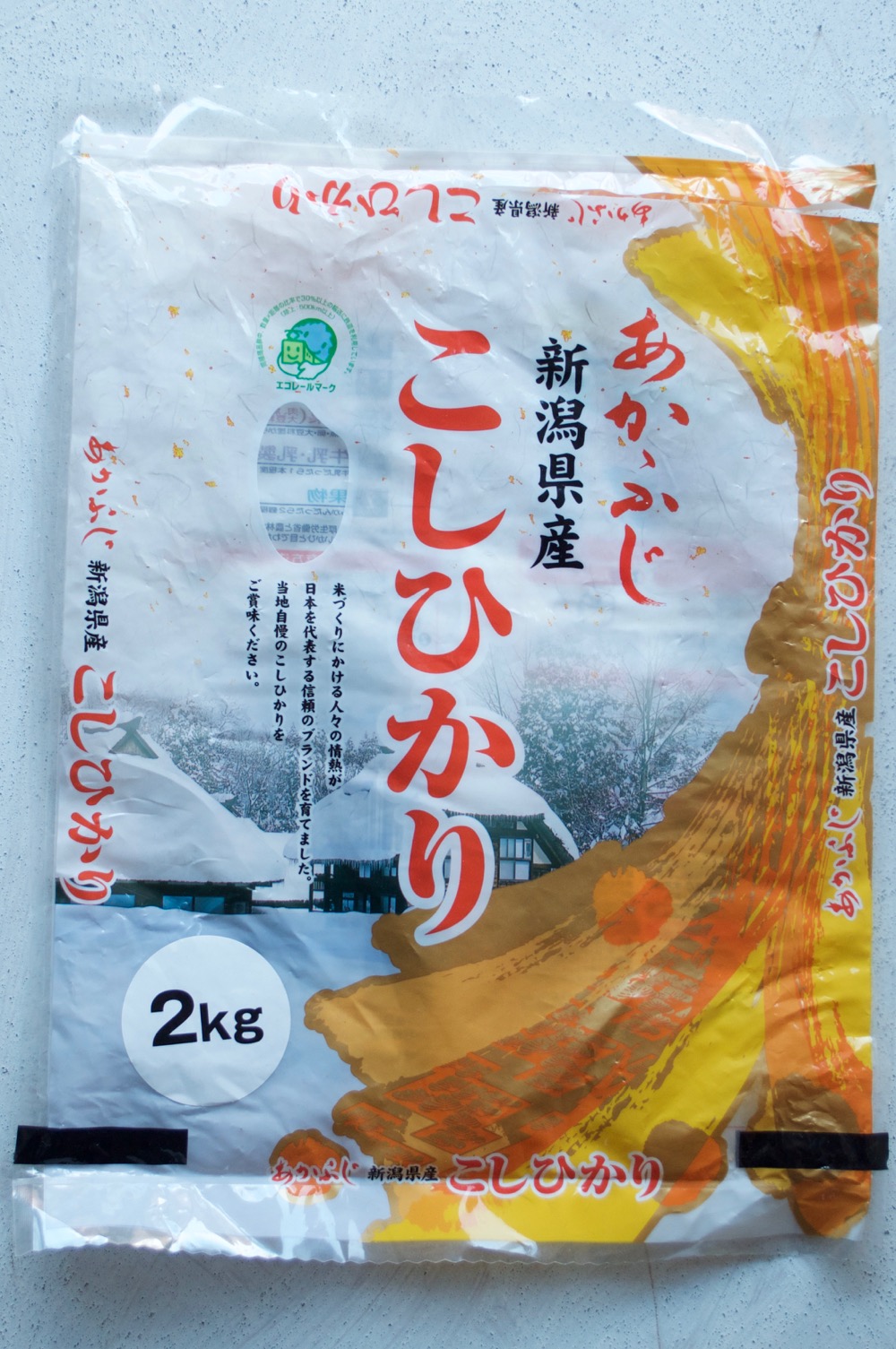
A bag of Koshihikari rice.
The Australian brand SunRice produces Koshihikari rice. You can even buy it at supermarkets these days.
From the original Koshihikari species, several new brands of rice were developed. They are Akitakomachi (あきたこまち), Hitomebore (ひとめぼれ) Hinohikari (ヒノヒカリ) and Milkyqueen (ミルキークイーン). Each of them has unique characteristics that are different from Koshihikari. You can buy some of these brands at Japanese grocery stores.
Another well-known rice brand that used to be neck and neck with Koshihikari is ‘Sasanishiki’ (ササニシキ or ささにしき). Unfortunately, Sasanishiki rice suffered from the extreme cold weather from 1980 to 1983 and the farmers had to reduce production of Sasanishiki rice significantly.
Sasanishiki (left photo below) is known to be best suited for sushi and sushi chefs in Japan are fond of this brand. As mentioned in my post Take Away Sushi Rolls, Sasanishiki rice is less glutenous than other species, so the sushi rice does not become sticky when sushi vinegar is mixed. You can still buy Sasanishiki rice at some Japanese/Asian grocery stores.
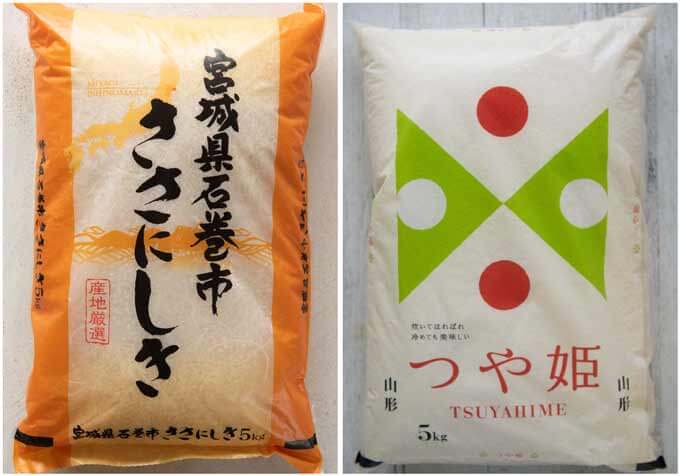
I sometimes buy the new rice brand called Tsuyahime (つや姫) at a Japanese grocery store (right photo above). The cooked rice is whiter and shinier than other brands. In addition to the appearance, it has a good balance of sweetness, umami, and stickiness. It was developed from the mutant of Koshihikari that was found 4 generations earlier.
The Japanese Way of Cooking Rice
Firstly, please do not cook Japanese rice in the same way as cooking pasta. I know that many Aussies simply boil cook their rice in a large amount of boiling water. It gave me a shock when I first learnt this. If you want to cook this way, please do not use the Japanese brand rice.
You can cook rice the Japanese way in a pot/saucepan on a cook top or in an electric rice cooker.
Cooking Rice in a saucepan on cook top
If you need to cook rice in a pot and want to make it just like the Japanese do, please follow the step-by-step instructions in the recipe. It might not look like as simple as you think, and you might wonder if you should be bothered making this much effort just for rice. But once you get used to it, it’s a simple process and you will never want to boil rice like pasta anymore.
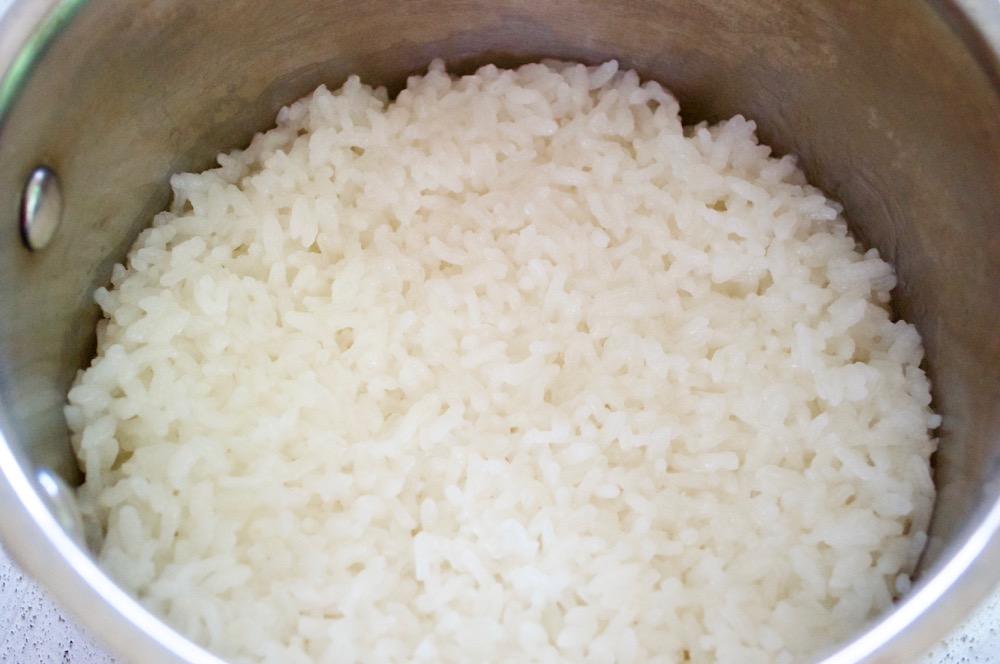
The key points are:
- Wash rice well – the powder around the rice makes the rice stickier.
- Soak the rice in water to let the rice grains absorb water – to cook rice evenly to the core of the grains.
- Rest after the heat is turned off – to make the rice fluffier.
- Mix the rice by turning the rice over from the bottom – to let the excess moisture evaporate.
Cooking Rice in a Rice Cooker
A rice cooker should come with a measuring cup. It is best to measure the rice with the cup provided.
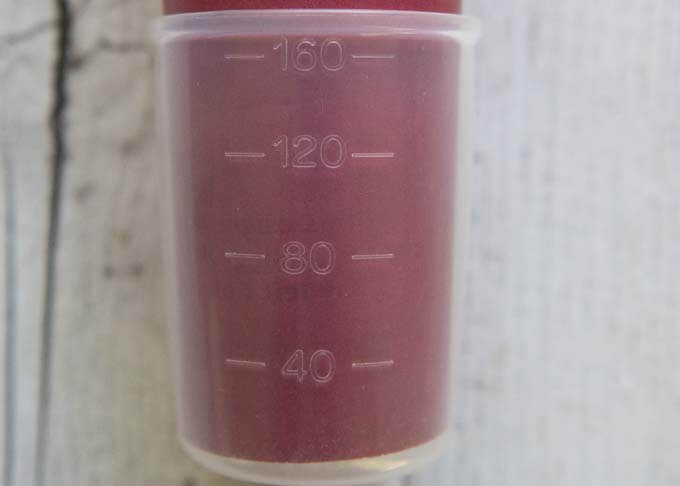
The capacity of the cup is 180ml / 6.1 fl oz, which is much smaller than the standard measuring cup. It is an odd volume as a metric unit, but it is not so odd if you think about the history of Japan. The next section explains the reason for it.
A rice cooker comes with an inner pot that goes inside the rice cooker. You will see the lines and numbers marked on the inside of the inner pot. These numbers indicate the water level required for the corresponding number of rice measuring cups. For example, if you are cooking 2 cups of rice, fill water to the line marked ‘2’, with the rice in it.
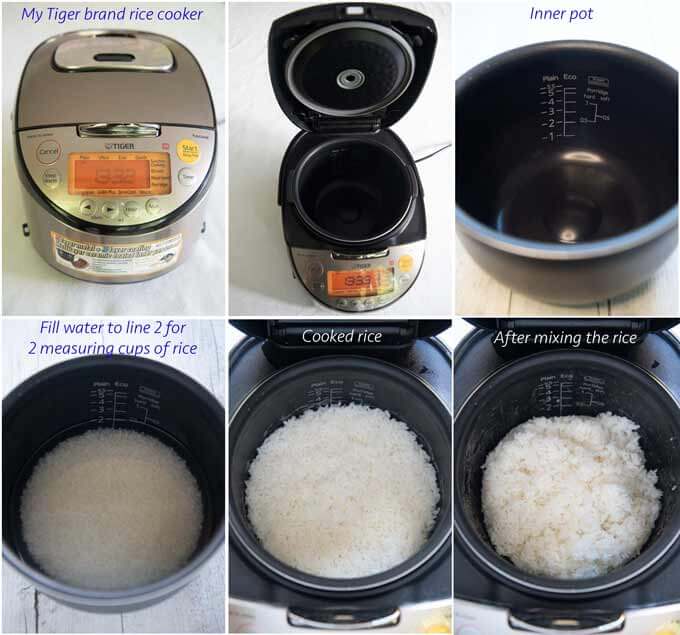
Even if you are cooking rice with a rice cooker, the 4 key points that I listed in the previous section applies. But if your rice cooker includes the water absorption time and the resting time in the cooking process, only the first and last key points apply.
Because you simply add water to the level indicated on the pot, there is no need for you to accurately measure the amount of water to put in the pot. So, I usually wash rice in the inner pot, add water to the required level, then turn the switch on.
Why is the rice measuring cup 180ml / 6.1 fl oz?
The capacity of 180ml comes from the old Japanese unit of measuring volume called ‘gou‘ (合). Until the Meiji Restoration, which ended the Edo period, Japanese people were using their own units to measure volume.
Gou is the second smallest unit. Instead of a plastic cup (as there was no such thing as plastic), people used a square wooden cup, which is almost equivalent to 180ml (180.39ml to be exact). The next level of unit is ‘shou‘ (升), which is 10 times of gou. 10 times of shou is ‘to‘ (斗, pronounce as /tɔ/ – the sound of toy without ‘i’), then 10 times of to is ‘koku‘ (石).
Traditional Japanese wooden measuring cup is called ‘masu’ (枡).
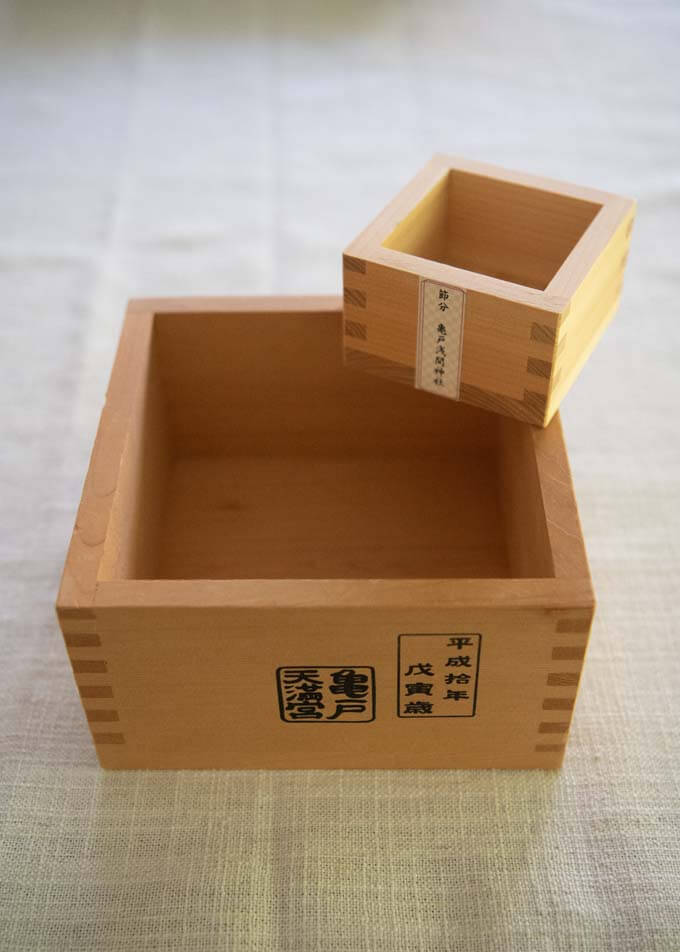
The volume of the small wooden measuring cup is 1 gou masu (about 180ml), the large cup is 1 shou masu (about1.8L).
In the Edo period, the farmers had to pay their tax to their feudal lords by way of supplying rice. So the prosperity of the feudal lords was expressed by the amount of rice, using the largest unit ‘koku‘ (石).
As part of the Meiji Restoration, the government replaced the old Japanese measurement units with the current metric system. But even now the old volume unit is still used for measuring rice.
Interestingly, the large bottle of Japanese sake is 1.8L / 3.8pt and people still call this bottle ‘isshōbin‘ (一升瓶), which means 1 shou bottle. Some Japanese restaurants serve cold sake in a skinny glass placed inside an ‘ichigou masu‘ (一合枡, 1 gou wooden measuring cup) – the small wooden cup in the photo above. Sake is associated with rice after all.
Japanese Etiquette when eating rice
If you would like to serve cooked rice (gohan, ご飯) the Japanese way, you will need a small bowl specifically made to serve rice called ochawan (お茶碗). As an alternative, you can serve the rice in a small ceramic bowl with a foot (i.e. base) so that you can hold the bowl without your fingers getting too hot.
You hold ochawan with one hand by placing the foot of the bowl on four fingers and the thumb on the rim, and hold chopsticks (箸, hash or お箸, ohashi) on the other hand (see the photo below). Yes, you do lift the bowl when eating rice. In fact, if you eat rice out of the bowl without lifting it from the table you will be considered to be lacking etiquette.
To eat the rice from the rice bowl, use your chopsticks and pinch a mouthful of rice, lift and move the chopsticks to your mouth. Placing the rim of the bowl to your mouth and sliding the rice into your mouth with chopsticks is considered to be bad manners.
In this recipe, I have included some typical condiments that Japanese people eat with rice to give it flavour. See the photo below – rice with umeboshi (梅干し, the pickled plum in the top right of the rice bowl), takuan (沢庵, pickled radish, yellow) and tarako furikake (ふりかけ, cod roe flavoured rice seasoning). You can just eat rice with these toppings without any other dishes.
Yumiko![]()
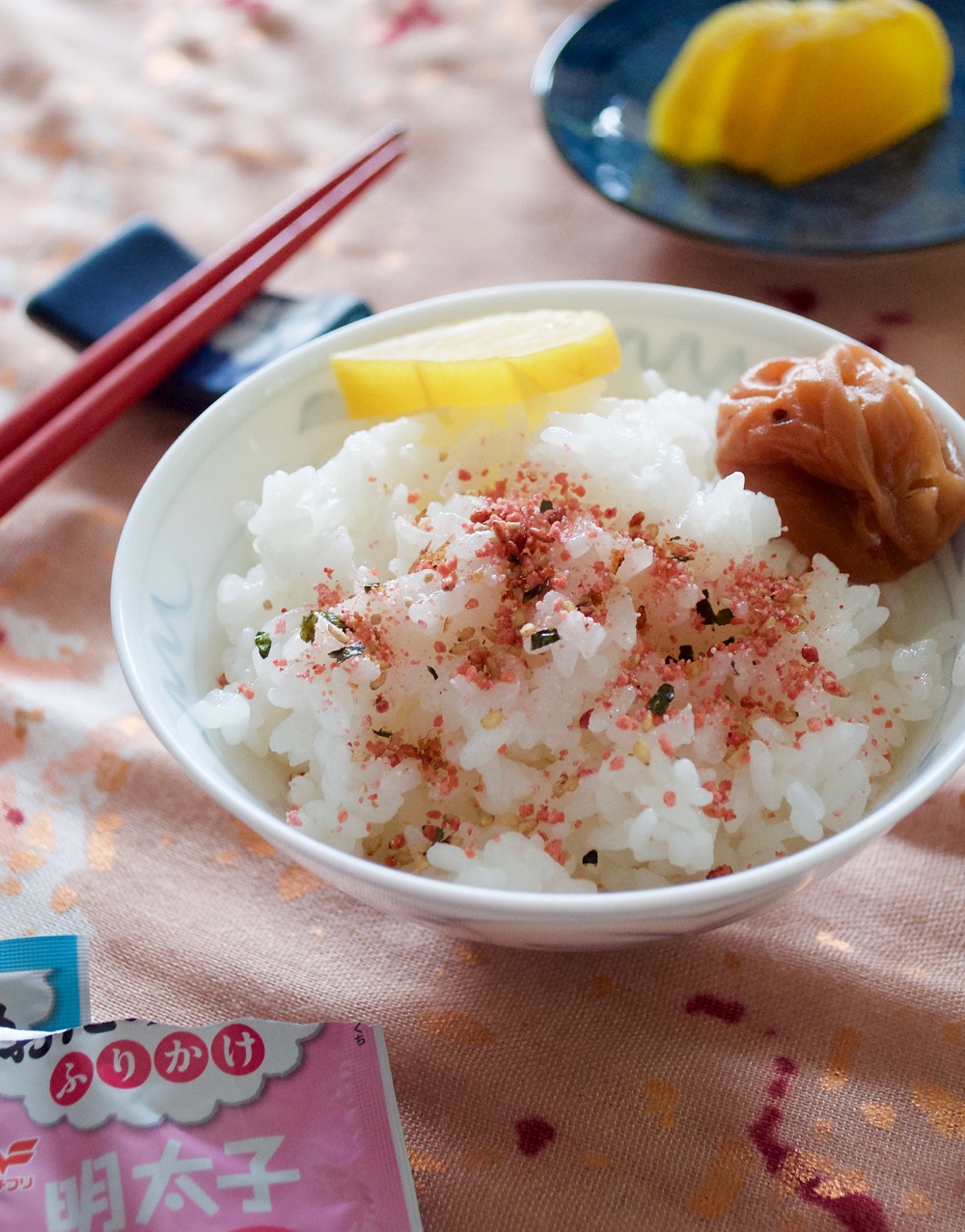
Originally published in August 2016. Added a recipe for cooking rice in a rice cooker, and improved photos and contents (no change to the original recipe).
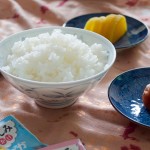
The Japanese way of cooking rice takes time, but the cooked rice is fluffier than it would be if you used the boiling method (it will not be soggy). Once you master it, you will not want to cook rice any other way!
The prep time does not include soaking time which varies depending on the season.
- 1 cup short grain or sushi rice (Note 1)
- 1 cup + 2-3 tbsp water (Note 2)
- Furikake (Cod roe flavoured rice seasoning)
- Umeboshi (Pickled plum)
- Takuan (Pickled white radish)
-
Accurately measure and place the rice in a large bowl. Add enough water (not in ingredients) to cover the rice and wash gently, then discard the water. Repeat the process 4-5 times until the water is almost clear.
-
Leave the rinsed rice in the bowl and add enough water (not in the ingredients) to cover the rice. Leave the rice to soak for 30 minutes (summertime) to 1 hour (wintertime). (Note 3)
-
Using a sieve, drain the rice and remove as much water as possible.
-
Place the rice in a saucepan with a heavy bottom and add water (per the ingredients list). Cook over medium heat with a lid on.
-
When the water starts boiling and bubbles come out of the pot, reduce the heat to low. Cook for 12-15 minutes until there is no water at the bottom of the pot or you don’t hear a bubbling sound from inside the pot. Do not open the lid while cooking.
-
Turn the heat off and leave for at least 10 minutes with the lid on. Then mix the rice using a rice spatula (if you have one). This is to remove excess moisture within the cooked rice grains. Also the rice does not to mould into the shape of the pot at the bottom.
-
Furikake (ふりかけ) is a dried Japanese seasoning that is sprinkled on top of cooked rice. Ingredients include a combination of dried fish flakes, dried egg, dried cod eggs, bonito flakes, sesame seeds, chopped seaweed and other flavourings.
-
Umeboshi (梅干し) is a salty and sour pickled plum. There are brown umeboshi (natural colour) and red umeboshi (dyed using purple perilla). Large umeboshi are about 2-3 cm (¾-1¼") diameter and have a very soft texture, while tiny umeboshi are normally crunchy. The seed inside an umeboshi is very hard and you should not eat it as you might break your teeth.
-
Takuan (沢庵) is one of the many pickled vegetables that Japanese people love. Unlike some of the western-style pickling, Japanese people do not use oil to pickle vegetables. They typically use any combination of salt, soy sauce and vinegar.
1. Short grain or sushi rice are the closest types of rice to Japanese rice. You could use medium grain, but long grain or any other rice grains are not suitable. I buy Japanese short grain rice called ‘Koshihikari’ (こしひかりorコシヒカリ). I like it because the cooked rice is fluffier and shinier than other types. In Australia, you can buy Koshihikari at most Asian grocery shops and definitely at Japanese grocery shops.
2. The amount of water required depends on your preference for the cooked rice (al dente vs soft), age of the rice grain (new rice needs less water), and the pot you use (more steam evaporates with a wider pot). You will need to experiment and work out the exact amount that suits you.
3. This is a traditional way of cooking fluffy rice. You will see that each grain becomes white after absorbing the water. If you don’t have time to soak the rice in the water, you can cook it straight away. In this case you might need to increase the amount of water slightly when cooking the rice.
4. If you are using the rice for sushi, placer a pice of konbu on top of the water, then cook rice. The rice will absorb umami from the konbu.
5. Leftover rice can be kept in the fridge for a few days or in the freezer. Use the microwave to thaw and re-heat.
6. Because of the strong flavour of these condiments, Japanese people sometimes eat rice with just these when they are in a hurry or just to fill themselves up without going through the hassle of cooking a meal.
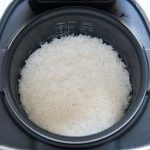
A rice cooker should come with a measuring cup. The capacity of the cup is 180ml, which is much smaller than the standard measuring cup. It is best to measure the rice with the cup provided.
The time taken to cook rice varies depending on the cooking option selected. I have indicated the longest cooking time (includes water absorption and resting time) on my Tiger brand rice cooker.
- 2 rice cooker cups of rice (180ml x 2 / 6.1 fl oz x 2)
- Water
-
Remove the inner pot from the rice cooker and put the rice in the pot.
-
Add enough water to cover the rice and wash it gently, then discard the water. Repeat the process 4-5 times until the water is almost clear.
-
Add water to the line marked ‘2’ on the side of the inner pot. Shake the pot gently and level the surface of the rice. (note 7)
-
Wipe off the water around the outer surface of the inner pot and place it in the rice cooker.
-
Leave it for 15 minutes to let the rice absorb water (note 2).
-
Turn the switch on.
-
When the rice cooker completes cooking, let the rice rest for 10-15 minutes with the lid on (note 3).
-
Using a rice spatula (note 4), mix the rice by turning the rice over from the bottom, then mix (note 5). This process lets the excess steam evaporate, preventing the rice from getting too sticky.
1. Measure the rice using the cup that came with the rice cooker. If you lose the cup, use a measuring cup and measure 360ml / 12.2 fl oz of rice.
2. This step is required only if your rice cooker is a very simple rice cooker with no menu options, or you are using the Quick Cook option on more advanced rice cookers. Advanced rice cookers that take 50-60 minutes to finish cooking (standard cooking option) includes the water absorption time.
3. This step is required only if your rice cooker is a very simple rice cooker with no menu options, or you are using the Quick Cook option on more advanced rice cookers. This is called the steaming process and it allows the excess moisture in the pot to evaporate. Advanced rice cookers that take 50-60 minutes to finish cooking includes the steaming process.
4. A plastic rice spatula usually comes with the rice cooker. But if don't have one, use a plastic/wooden round spatula. Never use a metal spoon if your inner pot has a non-stick coating.
5. It is easier if you make a cross on the surface of the rice and turn ¼ of the rice at a time to turn over and mix.
6. When the rice is cooked, the rice cooker should switch to 'warm' mode to keep the cooked rice warm. It is recommended not to keep it warm for more than 5-6 hours to maintain the quality of the cooked rice.
You can leave it warm for 12-24 hours, but the rice becomes dry. The flavour also degrades. It is better to take the rice out of the rice cooker and keep it in the fridge or freeze it.
7. If you are using the rice for sushi, placer a pice of konbu on top of the water. The rice will absorb umami from the konbu.
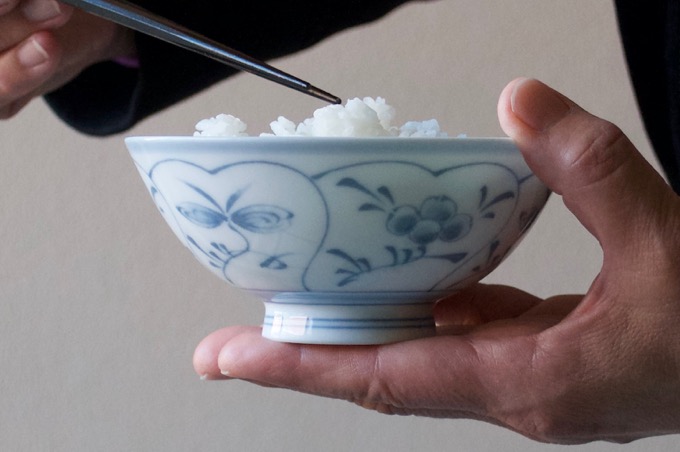
Where I live, the only access to purchase any sushi or short grain rice is Amazon. I was looking for koshihikari but have found it’s region/brand specific (I was unaware of this).
Which do you suggest? I’ve found Niigata, Ubara, Yamaguchi, and Uonumo (which is outrageously expensive😳). I might, that’s a big might, splurge and get Uonumo for a special occasion, but only if it’s worth it.
My grandmother was Japanese and immigrated to the US as an infant. She married into the Army and my grandfather, her husband, was eventually stationed in Japan. My father only lived there a very short while as a child but grew up having home cooked Japanese meals. I even grew up eating Japanese food until my grandmother died. My mother learned most of the recipes, but, Americanized them and has never taught me; she’s forgotten most of them now. Growing up, my father always did the frying of everything and mother the soups and broths.
Now, at 44, I’m JUST learning the art of sushi. I’ve mastered a lot of hibachi styled food but just started sushi, mainly because I crave it constantly and don’t have anywhere, within a 60 mile radius to get it, and the closest place is not my favorite I’ve had.
Now, I really want to learn the art of rice, especially after reading your blog. I’ve always been able to tell the difference in rice flavor and textures. Now, I’d love to know the differences in the regions and brands of koshihikari and what that means for it’s flavor.
Hi Zachari, I am not like my brother in law, who can tell the difference when he eats a different brand of rice, so I don’t have a particular brand/region of Koshihikari I always buy. I think any of them are good. If you have a luxury of being able to buy few different brands, you would be able to compare them tell the different in appearance, taste and texture. Then you might pick one brand you like.
The price of Koshihikari rice can vary depending on how they were grown and processed to get the the final state of the rice. In addition to that, Uonuma Koshihikari has been gaining a A++ grade every year in accredited taste testing. Uonuma is the city that produces most Koshihikari.
I often buy Tsuyahime from Yamagata prefecture. The cooked rice is shinier than other Koshihikari brands’ rice. I initially bought it thinking that the rice would look good in the photos (haha). But the flavour is good too and I liked it. At the Japanese grocery store where I usually buy a bag of rice, Tsuyahime is not always available. Then I try different brand.
Below is a Japanese site but this site explains the difference between the Koshihikari from all sorts of regions and brands. Google translate might give you some ideas.
http://monomania.sblo.jp/article/78591315.html
Wishing you a good luck with your new pursuit!
Oh my, I have died and gone to heaven when I found your site Yumiko san. I visited Japan many times and lived in Hiroshima for a year. Travelling around Japan I became a connoisseur okonomiyaki. I felt that Hiroshima’s was the best and lo, you have a recipe on your site. The owner of my favourite place in Hiroshima took me to his favourite okonomiyaki restaurant.
In the past I did cook a lot of Japanese style food but not so much any more. It is fun to read your recipes and remember the past.
Hi Susan, welcome to RecipeTin Japan! I am glad you enjoy reading my posts.
Vanakkam
Murli Chennai Tamil Nadu South India
I am glad to know more about Japanese Cuisine
Certain foods same as of our South Indian dishes.
I would like to share our traditional South Indian
Menu’s.
I have gone through the way cooking rice of u r
style.
If u r interested about our South Indian Traditional Cusine I can post.
Thanks a Lot.
Wish You Happy New Year 2020.
Best Regards,
Murli Priyam.
Hi Muri, thank you very much for trying the way Japanese cook rice. I am sure it is quite different from the Indian way.
I love South Indian dishes but I would like my blog site, RecipeTin Japan, to be just the site with a collection of Japanese home cooking recipes. I am sorry.
I wish you a Happy New Year!
Can you kindly share the cooking with electric rice cooker or is same as above method
Hi Kebo, you can still wash the rice before cooking. But different rice cookers have different amount of water to cook. So, it is a bit difficult to answer to your question. Some rice cookers even have water level indicators in the cooking bowl based on the number of cups of rice you cook. You need to follow the instruction of the rice cooker after washing the rice. If your rice cooker has measurement for different types of rice, use short/medium grain rice or white rice, not sushi rice.
I hope this helps.
Hi
I’m in California and although I visited Tokyo many years ago I have not lived in Japan.
A grandson loves all foods Japanese and a granddaughter lived there during that tragic earthquake several years ago. I am a fan of all foods Japanese that i have tried Love your blog and Nagi’s As well! Keep it coming please.
Hi Stella, thank you. I wish I could post more often like Nagi. Sorry. But I am meant to be retired. So, once a week is just right for me. I will keep sending, though!
Hi mum! Where are the directions for cooking rice with a rice cooker? Can you add it to the recipe card? Thanks!
OK, will do. Also I recently cooked rice in the Japanese clay pot used to cook hot pot. The rice turned out to be so good. Better than the rice cooked on a stainless pot. I might add this to the post, too.
Okay, I am over a year late but this interaction is adorable bahahaha. Gladys.
Thanks, Gladys.
Can I use a rice cooker to cook Japanese rice
Hi Simone, of course, yes! I use my rice cooker at all times. If your rice cooker comes with different water levels depending on the type of rice grains, choose short grain.
Hi Yumiko, I’ve got a zojirushi rice cooker, which has both sushi rice and white rice settings- which should i use for koshihikari rice?
thanks
peter
Hi Peter, good on you. When you are going to eat the cooked rice just like normal rice, use the white rice setting. Only when you are making sushi rice, i.e. adding sushi vinegar after the rice is cooked, use the sushi setting. The settings do not change even if you are using koshihikari or other short grain rice.
The difference is that the sushi setting cooks the rice slightly harder than the white rice setting in anticipation that you will be adding liquid immediately after the rice is cooked.
Enjoy the new toy.
Hi Yumiko -san,
When I was a little girl we lived in Japan and the big thing I remember was the ‘rice cakes’ that our cook used to make for me.
Wondering if you would have a recipe!
After reading this article I can understand now why the rice tasted different from the rice eaten in Aus.
Hi Marilyn, I personally haven’t made rice cakes from scratch as I could buy them at Asian grocery stores. But if you want to make it, here is the basic steps:
1. wash sticky rice (all called sweet rice/glutenous rice) well and soak in generous amount of water overnight.
2. Spread a muslin on a steamer, spread the soaked rice on the muslin and steam for 20-25 minutes.
3. While very hot, transfer the rice to a large bowl or a mortar and pound the rice using a pestle until the grains are completely pounded and the rice becomes smooth sticky texture (=rice cake).
4. You can shape the rice cake into small balls, flat round shapes etc while warm and sticky. Eating it immediately is the yummiest. As it gets cooled down, the rice cake hardens. You can leave it at room temperature to let it harden then store.
Thanks for asking. I must try this one day!
Oh yes, thank you not only for the rice recipe but for the making of rice cakes.
Very wonderful.
I was going to mention needing to find a recipe to go along with this for octopus with sunomono dressing, then found you provided one! So I’m all set now.
Kokorokara no kansha!
Hi Gregory, douitashimashite. I’m glad you find my collection of recipes useful! Happy New Year and have a great 2020!
I’ve tried to make Japanese-style rice several times before without success; but your recipe just worked out wonderfully for me. Thank you!
Hi Fiona, I am really glad to hear that! Thanks for a feedback.
Hello, thank you for the detailed instructions 🙂 Any chance you might have a Takuan recipe? I’m trying to find one, but most recipes online are the Korean version. Sorry if it is the same, but I just had a Takuan Maki and the taste didn’t seem to match. Thank you
Hi Geronte, I have not experimented enough to post a recipe but here is a basis of my recipe.
you will need a whole daikon dried for about 7-10 days, rice bran (about 15% of the weight of dried daikon), salt (about 6-8%), Konbu strips, orange peel pieces, apple skin pieces, few large plastic bags, a weight which is 3 times of the weight of daikon. Mix all ingredients other than daikon, then place daikon and the mixture in two layers of a plastic bag. Ensure the mixture coats the entire daikon. Tie the bag, as close to the daikon as possible so that the mixture stays on the surface of the daikon. Place the bag in a larger bag and put a weight on the daikon bag. Leave in a cool dark room for about 7-10 days. When water comes up, reduce the weight to half, then leave it further 3 weeks or so.
It might be that the Korean version does not use rice bran.
Hello Yumiko,
Thank you for taking the time to write the recipe in full length! I’ll give it a try soon. Really interesting the orange and apple skin pieces. Didn’t expect that at all.
Thank you once more,
🙏
Thank you! I made perfect rice with your method. I live in Los Angeles where we are fortunate to have a large selection of Japanese stores and products available. I used “cal-rose” rice which is favored by many Japanese- Americans and it came out perfect.
Hi Gary, that’s really great!